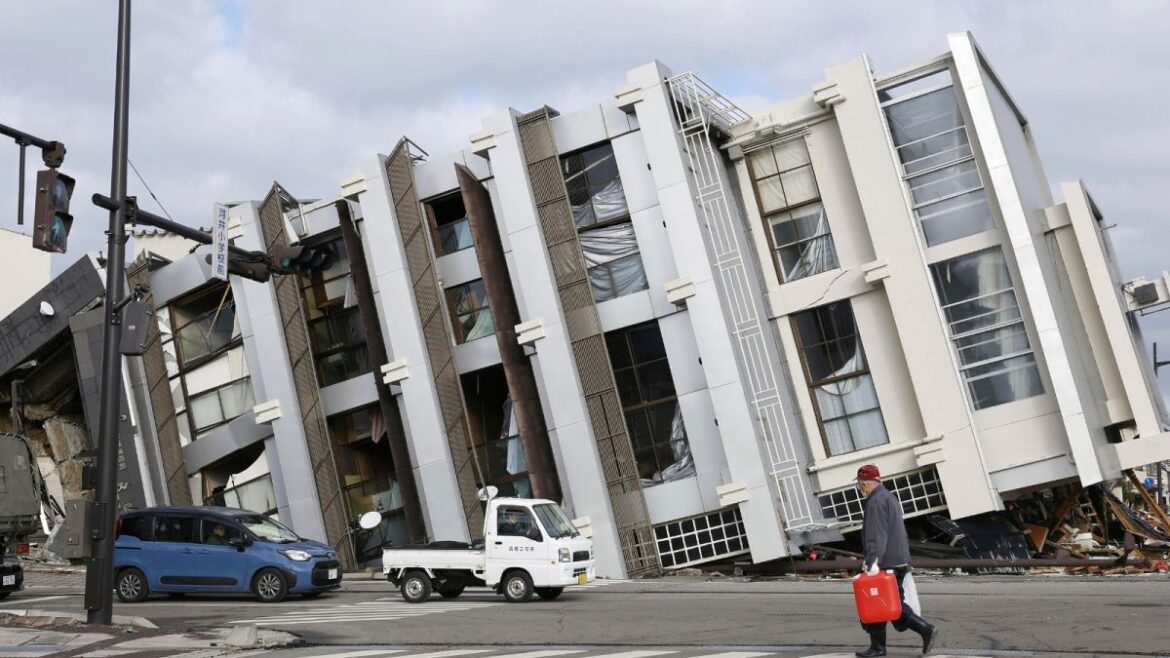Last Updated:April 02, 2025, 08:30 IST
A Japanese government report warned that there is an 80% chance of an 8 to 9 magnitude earthquake occurring along a tremulous seabed zone of the Nankai Trough
Nearly 1,500 earthquakes occur in Japan every year. Additionally, every five minutes, some form of seismic activity can be recorded in the country. (File Photo: AP)
As the world, and Myanmar per se, recovers from a massive 7.7-magnitude earthquake that hit the south-east Asian country last week, a Japan government’s report has warned of a “mega earthquake” anticipated on its Pacific Coast, which could trigger devastating tsunamis, infrastructure damage and potentially killing 300,000 people.
The expected economic damage of 270.3 trillion yen, or nearly half of the country’s total gross domestic product (GDP), according to a Cabinet Office report.
The Japanese government report alerted that there is an 80% chance of a magnitude 8 to 9 earthquake along a tremulous seabed zone known as the Nankai Trough.
Experts and officials have urged the people to remain calm, continue their daily social and economic activities, and prepare for emergencies by securing food, water, and discussing evacuation plans with family members.
What Does The Report Predict?
Under the worst-case scenario, based on a potential magnitude 9 earthquake in the area, Japan is likely to see 1.23 million evacuees or 1% of its total population. As many as 298,000 people could die from tsunamis and building collapses if the quake occurs late at night in winter, the report showed, as mentioned by Reuters.
Last year, Japan issued its first-ever megaquake advisory, stating that there was a “relatively higher chance” of a magnitude 9 earthquake in the trough, following a magnitude 7.1 earthquake near its edge.
In 2013, a Japanese government disaster prevention team warned that a magnitude 9.1 earthquake in the Nankai Trough could trigger a tsunami over 10 metres (33 feet) high within minutes.
Such an event could result in up to 323,000 deaths, the destruction of more than 2 million buildings, and economic losses exceeding 220 trillion yen ($1.5 trillion) across vast areas of Japan’s Pacific coast.
A 9.0-magnitude earthquake in 2011 triggered a devastating tsunami and the triple reactor meltdowns at a nuclear power plant in northeast Japan killed more than 15,000 people.
How Dangerous Is Nankai Trough?
The trough is located in Japan’s southwest Pacific coast and runs for approximately 900 km (600 miles), where the Philippine Sea Plate is subducting under the Eurasian Plate. The accumulating tectonic strains could result in a megaquake roughly once in 100 to 150 years.
According to the Japan Meteorological Agency (JMA), the Philippine Sea Plate exerts pressure on the Eurasian Plate in this region, occasionally causing it to snap back — a movement that could lead to a megaquake and tsunami.
As the plates move, they become stuck, accumulating immense amounts of energy that are released when they break free, possibly causing massive earthquakes. The tectonic strain that has built up over centuries in the Nankai Trough poses a huge threat, as it could lead to a series of megaquakes, a Firstpost report mentioned.
Japan had previously predicted a 70-80% probability of an 8-9 magnitude earthquake occurring in this area in the next 30 years.
The Nankai Trough has experienced massive earthquakes every 100 to 150 years on average. Research from Tohoku and Kyoto Universities indicates that a magnitude 7+ quake in the region increases the likelihood of a following tremor by 100 to 3,600 times within a week.
So far, the most powerful earthquake ever recorded was a magnitude of 9.5 in Chile on May 22, 1960, occurring along a fault nearly 1,600 km (1,000 miles) long.
Why Japan Has So Many Earthquakes And Tsunamis
Japan is geographically situated on the top of four major tectonic plates. This makes the country prone to experiencing disturbing tectonic activity and earthquakes.
A retired geophysics professor at the University of Arizona and the University of Portland Robert Butler explained that the more plates there are under a region, or, more precisely, the more plate boundaries there are adjacent to each other, the chances of interaction between these plates increase, triggering more earthquakes.
Seismologist Saeko Kita at an International Institute of Seismology and Earthquake Engineering expressed that Japan and the nearby areas actually account for over 18% of earthquakes occurring all across the globe, and these active tectonics are to be blamed.
Nearly 1,500 earthquakes occur in Japan every year. Additionally, every five minutes, some form of seismic activity can be recorded in the country.
Also, there exists a special zone shaped in the form of a horseshow called the ‘Ring of Fire’ along the Pacific Ocean. This zone, which begins from the east coast of Australia and stretches up to eastern Russia, has more than 400 active volcanoes. The region runs through through Japan as well, spanning along the western coast of Chile from the western coast of North America.
The ‘Ring of Fire’ region frequently experiences tsunamis, volcanoes, and earthquakes. Around 80% of the tsunamis and earthquakes in the world occur in this region, according to the International Tsunami Information Center and the US Geological Survey.
News explainers What’s Mega Earthquake That Japan Fears Could Kill 300,000 People? Explained


AloJapan.com